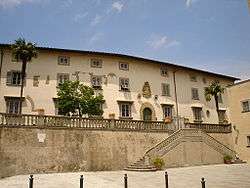Fiesole
Fiesole (Italian pronunciation: [ˈfjɛːzole]) is a town and comune of the Metropolitan City of Florence in the Italian region of Tuscany, on a scenic height above Florence, 5 km (3 miles) northeast of that city. Harvard University, Georgetown University, and Saint Mary's University of Minnesota all have their centers of Italian Renaissance Studies domiciled in Fiesole.[3][4] The Decameron by Giovanni Boccaccio is set in the slopes of Fiesole. The city was equally featured in the novels Peter Camenzind (1904) by Hermann Hesse, A Room with a View (1908) by E. M. Forster, and Italian Hours (1909) by Henry James.[5]
Fiesole | |
|---|---|
| Città di Fiesole | |
The hills of Fiesole overlooking Florence | |
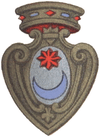 Coat of arms | |
Location of Fiesole 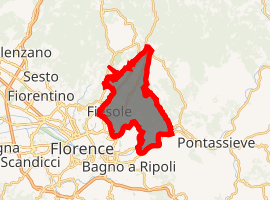
| |
 Fiesole Location of Fiesole in Italy  Fiesole Fiesole (Tuscany) | |
| Coordinates: 43°48′26″N 11°17′31″E | |
| Country | Italy |
| Region | Tuscany |
| Metropolitan city | Florence (FI) |
| Frazioni | Anchetta, Caldine, Compiobbi, Ellera, Girone, Pian del Mugnone, Pian di San Bartolo, San Domenico |
| Government | |
| • Mayor | Anna Ravoni |
| Area | |
| • Total | 42 km2 (16 sq mi) |
| Elevation | 295 m (968 ft) |
| Population (31 December 2014)[2] | |
| • Total | 14,075 |
| • Density | 340/km2 (870/sq mi) |
| Demonym(s) | Fiesolani |
| Time zone | UTC+1 (CET) |
| • Summer (DST) | UTC+2 (CEST) |
| Postal code | 50014 |
| Dialing code | 055 |
| ISTAT code | 048015 |
| Patron saint | Romulus of Fiesole |
| Saint day | 6 July |
| Website | Official website |
Since the 14th century the city has always been considered a getaway for the upper class of Florence and up to this day Fiesole remains noted for its very expensive residential properties. The city is generally considered to be the wealthiest and most affluent suburb of Florence. In 2016 the city had the highest median family income in the whole of Tuscany.[6]
History
Fiesole (Etruscan Viesul, Viśl, Vipsul) was probably founded in the 9th–8th century BC, as it was an important member of the Etruscan confederacy, as may be seen from the remains of its ancient walls.
The first recorded mention of the town dates to 283 BC, when the town, then known as Faesulae, was conquered by the Romans. In antiquity it was the seat of a famous school of augurs, and every year twelve young men were sent thither from Rome to study the art of divination. Sulla colonized it with veterans, who afterwards, under the leadership of Gaius Mallius, supported the cause of Catilina.[7][8]
Fiesole was the scene of Stilicho's great victory over the Germanic hordes of the Vandals and Suebi under Radagaisus in 406.[9] During the Gothic War (536–553) the town was several times besieged. In 539 Justin, the Byzantine general, captured it and razed its fortifications.
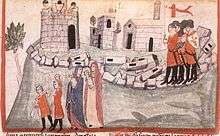
It was an independent town for several centuries in the early Middle Ages, no less powerful than Florence in the valley below, and many wars arose between them; in 1010 and 1025 Fiesole was sacked by the Florentines, before it was conquered by Florence in 1125, and its leading families obliged to take up their residence in Florence. Dante reflects this rivalry in his Divine Comedy by referring to "the beasts of Fiesole." (Inferno XV.73).[10]
By the 14th century, rich Florentines had countryside villas in Fiesole, and one of them is the setting of the frame narrative of the Decameron. Boccaccio's poem Il Ninfale fiesolano is a mythological account of the origins of the community.[11] Robert Browning mentions “sober pleasant Fiesole” several times in his poem, "Andrea Del Sarto".
Main sights
- Remnants of Etruscan walls.
- Roman baths.
- Roman theatre.
- Palazzo Comunale (Town Hall) of the 14th century.
- The cathedral of Fiesole (Il Duomo), containing the shrine of St. Romulus, martyr, according to legend the first Bishop of Fiesole, and that of his martyred companions, also the shrine of St. Donatus of Fiesole.
- The Badia or ancient cathedral of St. Romulus, built in 1028 by Bishop Jacopo Bavaro with materials taken from several older edifices, at the foot of the hill on which Fiesole stands, supposed to cover the site of the martyrdom of St. Romulus; it contains notable sculptures by Mino da Fiesole. The old cathedral became a Benedictine abbey, which passed into the hands of the Canons Regular of the Lateran. It once possessed a valuable library, long since dispersed. The abbey was closed in 1778.
- The room in the Episcopal Palace where Carmelite bishop St. Andrew Corsini lived and died.
- The little Church of Santa Maria Primerana in the cathedral square, where the same saint was warned by Our Lady of his approaching death. Built in 996 and further expanded in medieval times, has maintained the Gothic presbytery from that period. It received a new façade in the late 16th century, with graffito decoration by Ludovico Buti. The interior, on a single hall, has a 13th-century panel portraying Madonna with Child. In the transept are two marble bas-reliefs by Francesco da Sangallo, and a terracotta from Andrea della Robbia's workshop.
- The Church of S. Alessandro, with the shrine of St. Alexander, bishop and martyr.
- The Monastery of San Francesco on the crest of the hill, with the cells of St. Bernardine of Siena and seven Franciscan Beati.
- Church of San Girolamo, the home of Venerable Carlo dei Conti Guidi, founder of the Hieronymites of Fiesole (1360).
- San Domenico, the novice-home of Fra Angelico and of St. Antoninus of Florence.
- Fontanelle, a villa near S. Domenico, where St. Aloysius came to live in the hot summer months, when a page at the court of Grand Duke Francesco de' Medici.
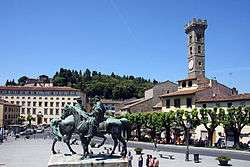
- Villa I Tatti, a campus of Harvard University
- Villa Medici in Fiesole.
- Villa Le Balze, a campus of Georgetown University
- Villa Palmieri
- Villa Schifanoia.
- Villa Sparta, former residence in exile of the Greek royal family
- Fonte Lucente, where a miraculous crucifix is greatly revered.
- Castello di Vincigliata
- Episcopal Seminary of Fiesole
In the neighbourhood are:
- Monte Senario, the cradle of the Servite Order, where its seven holy founders lived in austerity
- S. Martino di Mensola, with the body of St. Andrew, an Irish saint, still incorrupt.
- Monte Ceceri and the monument to Leonardo da Vinci's attempted flight
Notable residents
- Angelo Maria Bandini, Italian author
- Bernard Berenson, American art historian
- Giovanni Bocaccio, Renaissance humanist
- Arnold Böcklin, Swiss painter
- St. Andrew Corsini, a Florentine Carmelite friar(1302 – January 6, 1373), Bishop of Fiesole
- Alexandre Dumas, French writer
- Bridget of Fiesole, 9th century Irish nun
- Mino da Fiesole, Florentine sculptor (c.1429—1484) and painter
- Helen of Greece and Denmark, queen mother of Romania (was awarded the honorary title of Righteous Among the Nations in 1993 for her humanitarian efforts to save the Jews of Romania).
- Hermann Hesse, German writer, featured the city in his well-known novel Peter Camenzind
- Paul of Greece, King of Greece
- Paul Klee, German painter
- Francesco Landini (c.1325–1397), composer, singer, poet, organist and instrument maker
- Elisabeth Mann-Borgese, German writer
- Lorenzo Monaco (1370–1424), painter
- Marcel Proust, French writer
- Andrew the Scot, 9th century Irish archdeacon
- Gertrude Stein and Alice B. Toklas spent their summers in Fiesole before the First World War[12]
- Roger Verity Anglo-Italian entomologist
- Frank Lloyd Wright, American architect
- Miloš Crnjanski, Serbian writer and poet who wrote his 1973 poem Stražilovo in Fiesole.[13]
In art
- Wall mural in Grossi Florentino, executed by students of Napier Waller under supervision
See also
- Diocese of Fiesole
Notes
- "Superficie di Comuni Province e Regioni italiane al 9 ottobre 2011". Istat. Retrieved 16 March 2019.
- "Popolazione Residente al 1° Gennaio 2018". Istat. Retrieved 16 March 2019.
- http://itatti.harvard.edu
- https://villalebalze.georgetown.edu
- https://www.nytimes.com/2008/11/30/travel/30Florence.html
- http://www.infodata.ilsole24ore.com/2016/08/04/dove-vivono-i-piu-ricchi-ditalia-la-classifica-dei-comuni-con-i-redditi-piu-alti-2/
- Dictionary of Greek and Roman Biography and Mythology, William Smith, Editor.
- Gaius Mallius was a colonist of Fiesole who, according to Sallust (Bellum Catilinae 24.2), was the first to raise an army and take the field against Rome. His nomen is often confused with the more common Manlius.
- Radagaisus was executed 23 August 406 (Herwig Wolfram, Thomas J. Dunlap, tr., History of the Goths, 1988:169); Paulinus of Nola attributed the victory of Stilicho over Radagaisus's Ostrogoths near Fiesole, to the protection of Felix, Peter, Paul and other saints.
- Dante in Love, A.N. Wilson, p. 71 (Farrar, Straus and Giroux: 2011)
- Nocita, Teresa. "Giovanni Boccaccio: Tuscan mythologies". In Italo Pantani (ed.). Pathways through Literature. Internet Culturale. Archived from the original on 19 January 2015. Retrieved 12 January 2012.
- Gertrude Stein, The Autobiography of Alice B. Toklas, New York City: The Bodeley Head, Reprint: London: Penguin Classic, 2001, p. 96
- "Стара разгледница Чонграда Tома Црњански добија" (PDF). p. 43. Retrieved 16 May 2020.
References
- Mauro Marrani, Il contado fiesolano. Grafica European Center of Fine Arts, Firenze 2010. ISBN 978-88-95450-34-6
- Herbermann, Charles, ed. (1913). . Catholic Encyclopedia. New York: Robert Appleton Company.
External links
| Wikimedia Commons has media related to Fiesole. |
- . Encyclopædia Britannica. 10 (11th ed.). 1911.
- Official site
- Satellite image from Google Maps
